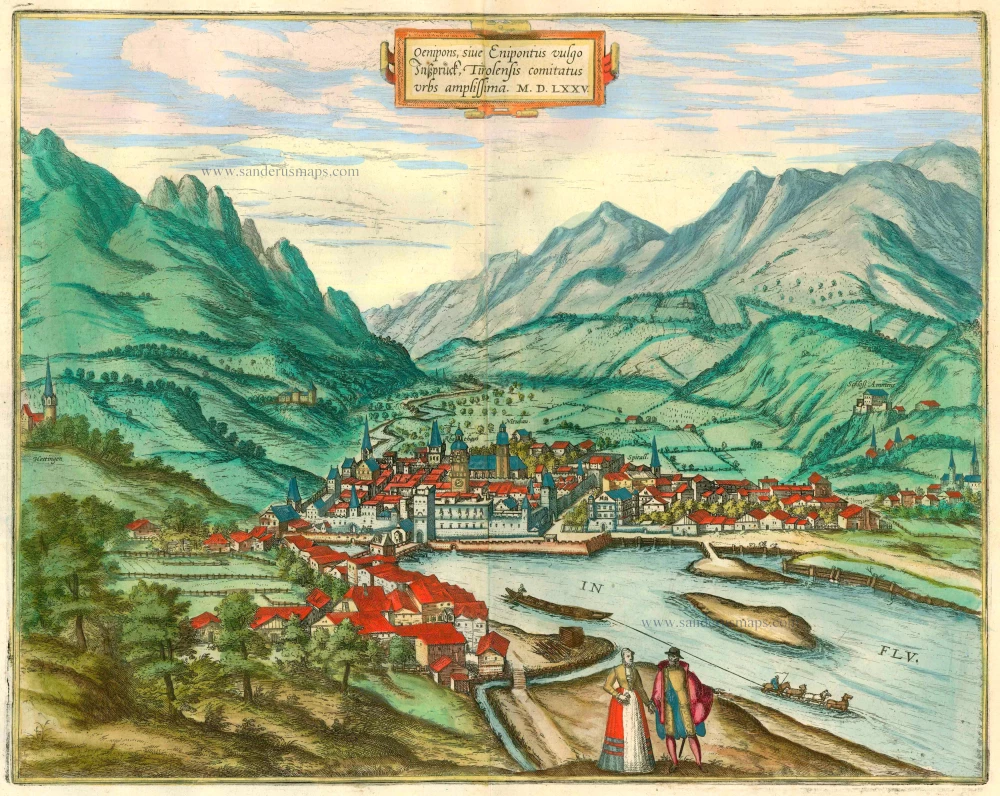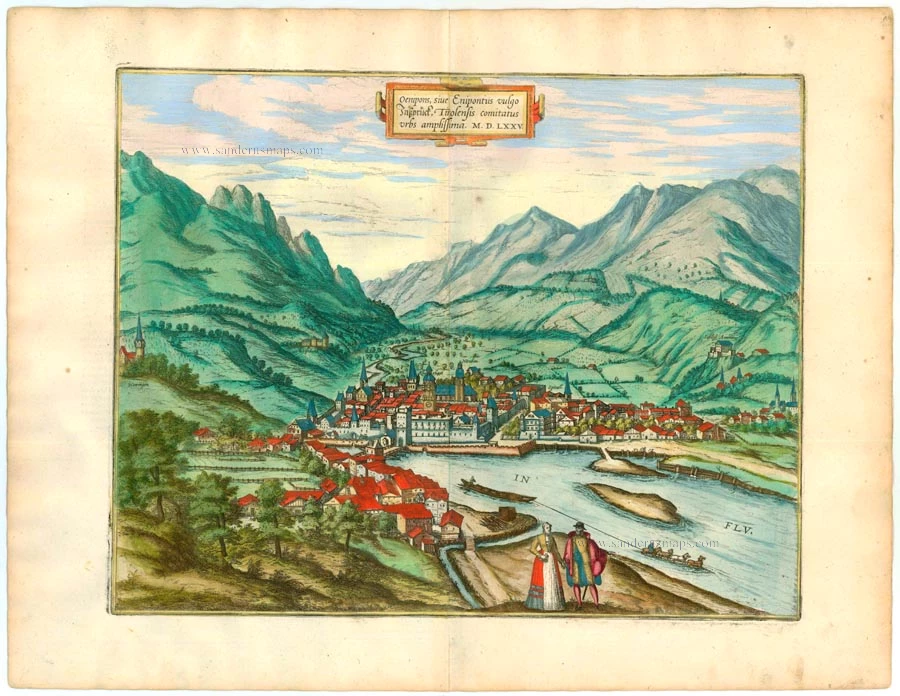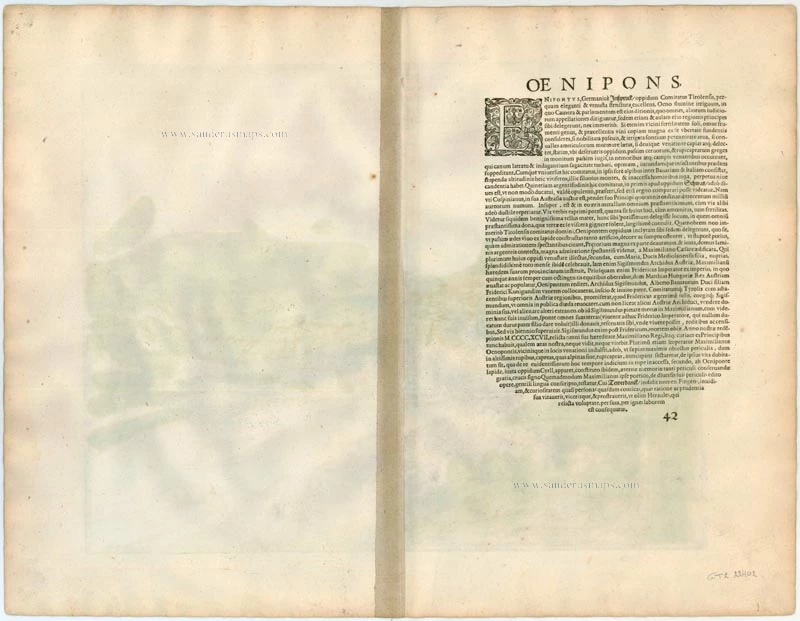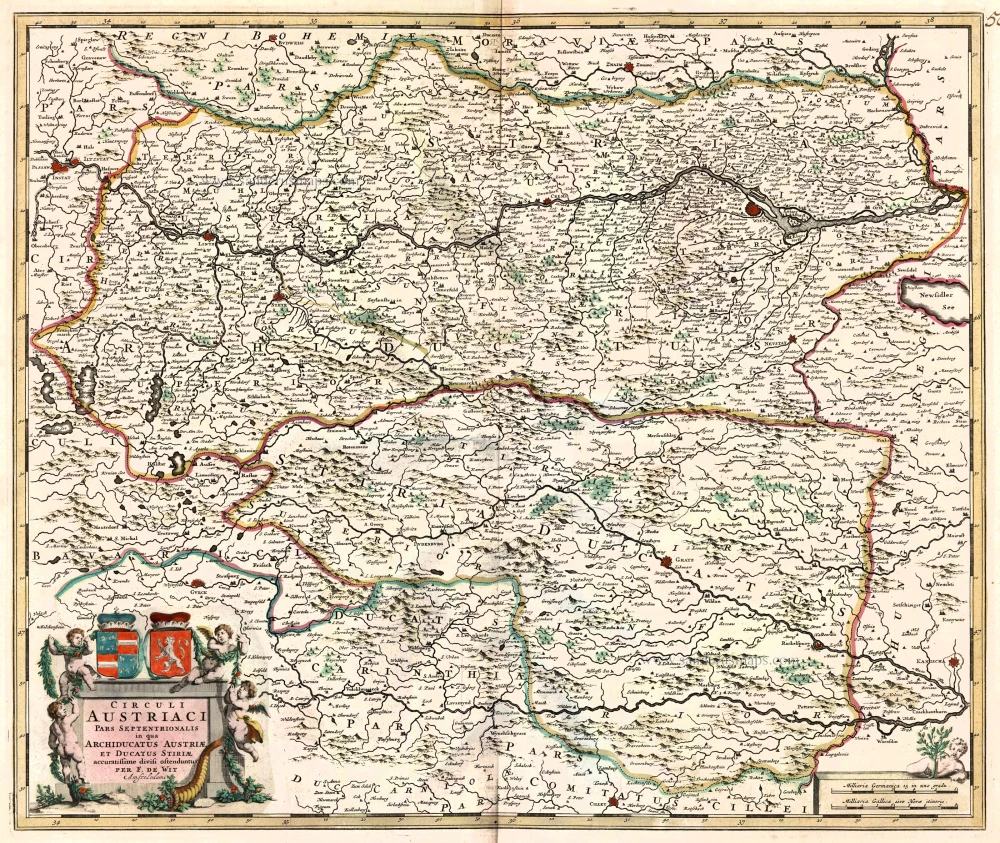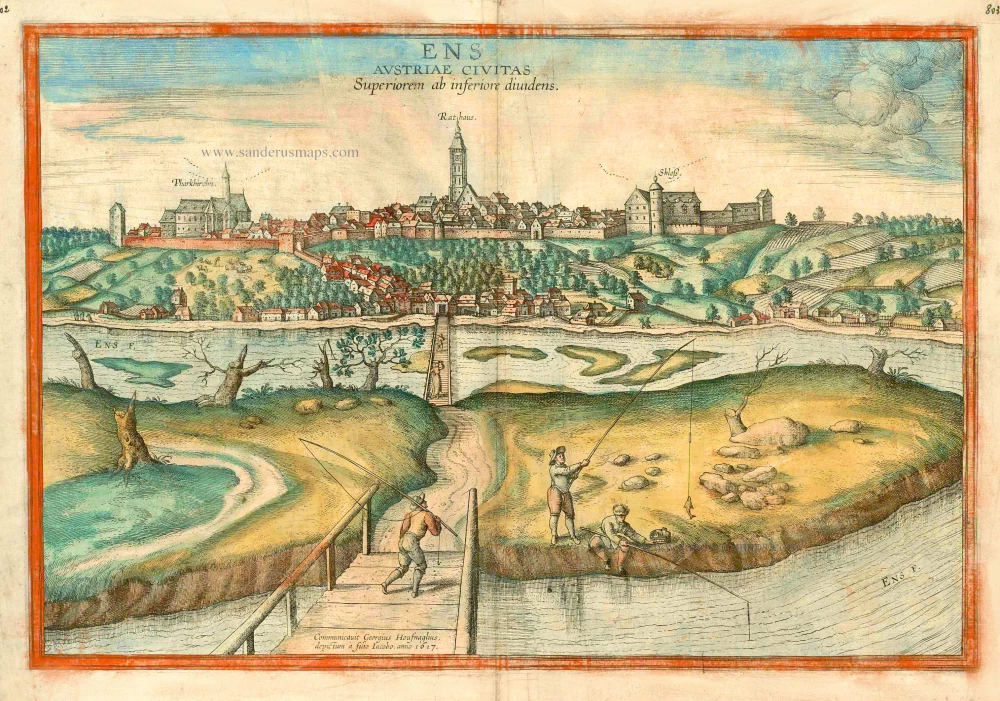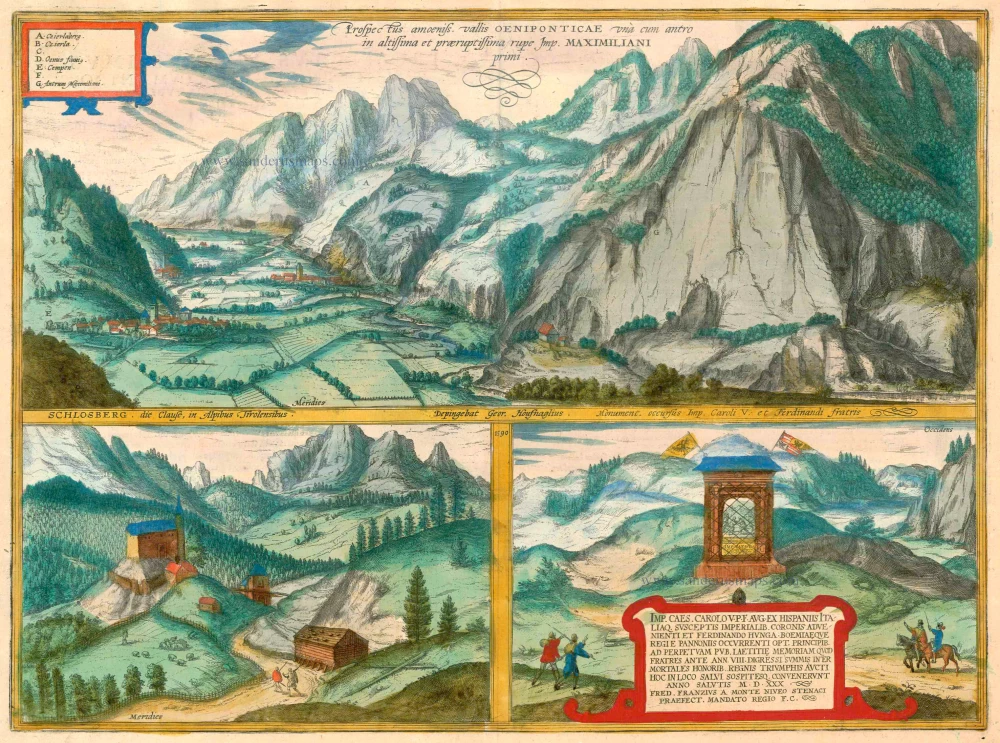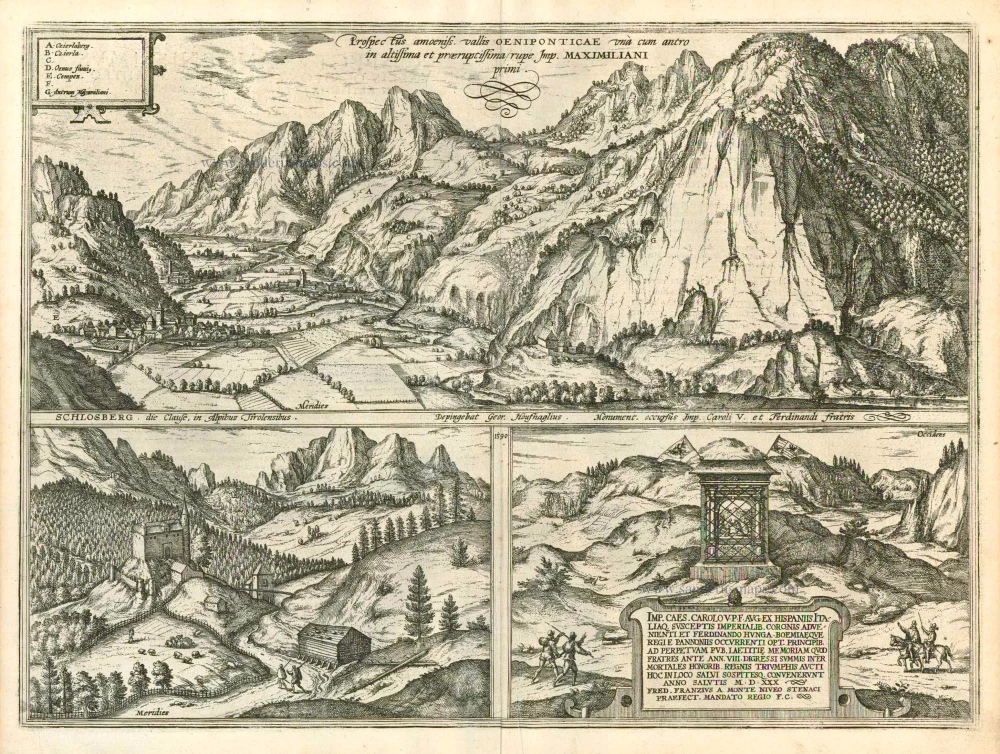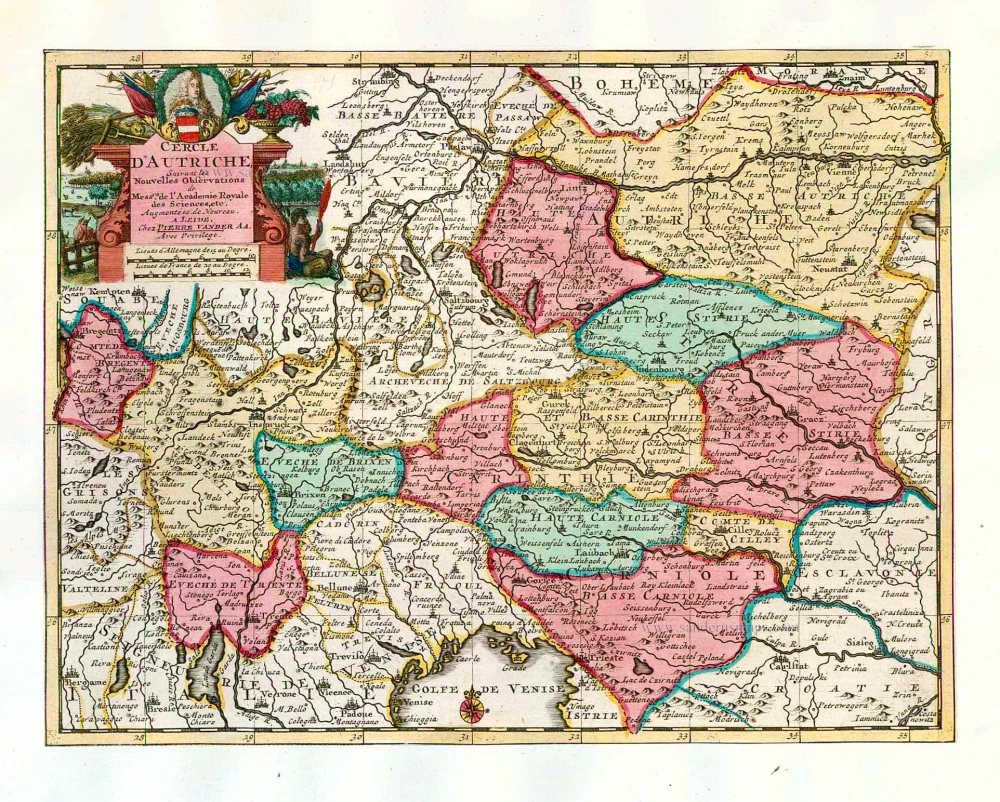Innsbruck, by Braun and Hogenberg. 1575-1612
TRANSLATION OF CARTOUCHE TEXT: Oenipons, or Enipontus, in German Innsbruck, a distinguished city of the Duchy of Tyrol. 1575.
COMMENTARY BY BRAUN: "Innsbruck has an indescribably advantageous position and fertile soil. Therefore, the sovereigns of the land chose it very early as their seat. ... There is a very fine town hall there, most of which is gilded, and another house, built by Emperor Maximilian, that is covered with silver tiles."
Innsbruck, the capital of the Tyrol, is shown from the west overlooking the district of Mariahilf. The town hall stands out with its characteristic tower. The Neuhofbuilding with the Golden Roof, a magnificent late Gothic oriel window, is not visible due to the chosen perspective, but the spire of the Gothic church of St James can be seen on the left. Today the 18th-century cathedral of St James stands on this site. The Gothic Spitalkirche (or hospice, on the right) was also replaced in the 18th century by a new, Baroque building. Innsbruck is mentioned for the first time around 1167 and was granted a municipal charter around 1200. In Braun and Hogenberg's day, the city was the residence of the Tyrol line of the Habsburgs (1564-1665) and had a population of about 5,000, which today has grown to over 139,000. (Taschen)
Braun G. & Hogenberg F. and the Civitates Orbis Terrarum.
The Civitates Orbis Terrarum, also known as the 'Braun & Hogenberg', is a six-volume town atlas and the most excellent book of town views and plans ever published: 363 engravings, sometimes beautifully coloured. It was one of the best-selling works in the last quarter of the 16th century. Georg Braun, a skilled writer, wrote the text accompanying the plans and views on the verso. Many plates were engraved after the original drawings of a professional artist, Joris Hoefnagel (1542-1600). The first volume was published in Latin in 1572 and the sixth in 1617. Frans Hogenberg, a talented engraver, created the tables for volumes I through IV, and Simon van den Neuwel made those for volumes V and VI. Other contributors were cartographers Daniel Freese and Heinrich Rantzau, who provided valuable geographical information. Works by Jacob van Deventer, Sebastian Münster, and Johannes Stumpf were also used as references. Translations appeared in German and French, making the atlas accessible to a wider audience.
Since its original publication of volume 1 in 1572, the Civitates Orbis Terrarum has left an indelible mark on the history of cartography. The first volume was followed by seven more editions in 1575, 1577, 1582, 1588, 1593, 1599, and 1612. Vol.2, initially released in 1575, saw subsequent editions in 1597 and 1612. The subsequent volumes, each a treasure trove of historical insights, graced the world in 1581, 1588, 1593, 1599, and 1606. The German translation of the first volume, a testament to its widespread appeal, debuted in 1574, followed by the French edition in 1575.
Several printers were involved: Theodor Graminaeus, Heinrich von Aich, Gottfried von Kempen, Johannis Sinniger, Bertram Buchholtz, and Peter von Brachel, all of whom worked in Cologne.
Georg Braun (1541-1622)
Georg Braun, the author of the text accompanying the plans and views in the Civitates Orbis Terrarum, was born in Cologne in 1541. After his studies in Cologne, he entered the Jesuit Order as a novice, indicating his commitment to learning and intellectual pursuits. In 1561, he obtained his bachelor's degree; in 1562, he received his Magister Artium, further demonstrating his academic achievements. Although he left the Jesuit Order, he continued his studies in theology, gaining a licentiate in theology. His theological background likely influenced the content and tone of the text in the Civitates Orbis Terrarum, adding a unique perspective to the work.
Frans Hogenberg (1535-1590)
Frans Hogenberg was a Flemish and German painter, engraver, and mapmaker. He was born in Mechelen as the son of Nicolaas Hogenberg.
By the end of the 1560s, Frans Hogenberg was employed upon Abraham Ortelius's Theatrum Orbis Terrarum, published in 1570; he is named an engraver of numerous maps. In 1568, he was banned from Antwerp by the Duke of Alva and travelled to London, where he stayed a few years before emigrating to Cologne. He immediately embarked on his two most important works, the Civitates, published in 1572 and the Geschichtsblätter, which appeared in several series from 1569 until about 1587.
Thanks to large-scale projects like the Geschichtsblätter and the Civitates, Hogenberg's social circumstances improved with each passing year. He died as a wealthy man in Cologne in 1590.
Oenipons, sive Enipontius vulgo Insspruck, Tirolensis Comitatus Urbs Amplissima MDLXXV
Item Number: 22402 Authenticity Guarantee
Category: Antique maps > Europe > Austria
Antique view of Innsbruck by Braun and Hogenberg.
Title: Oenipons, sive Enipontius vulgo Insspruck, Tirolensis Comitatus Urbs Amplissima MDLXXV.
Date: 1575-1612.
Copper engraving, printed on paper.
Size (not including margins): 340 x 425mm (13.39 x 16.73 inches).
Verso: Latin text.
Condition: Original coloured, excellent.
Condition Rating: A+.
From: Civitates Orbis Terrarum, ... Part 2. Köln, 1575-1612.
TRANSLATION OF CARTOUCHE TEXT: Oenipons, or Enipontus, in German Innsbruck, a distinguished city of the Duchy of Tyrol. 1575.
COMMENTARY BY BRAUN: "Innsbruck has an indescribably advantageous position and fertile soil. Therefore, the sovereigns of the land chose it very early as their seat. ... There is a very fine town hall there, most of which is gilded, and another house, built by Emperor Maximilian, that is covered with silver tiles."
Innsbruck, the capital of the Tyrol, is shown from the west overlooking the district of Mariahilf. The town hall stands out with its characteristic tower. The Neuhofbuilding with the Golden Roof, a magnificent late Gothic oriel window, is not visible due to the chosen perspective, but the spire of the Gothic church of St James can be seen on the left. Today the 18th-century cathedral of St James stands on this site. The Gothic Spitalkirche (or hospice, on the right) was also replaced in the 18th century by a new, Baroque building. Innsbruck is mentioned for the first time around 1167 and was granted a municipal charter around 1200. In Braun and Hogenberg's day, the city was the residence of the Tyrol line of the Habsburgs (1564-1665) and had a population of about 5,000, which today has grown to over 139,000. (Taschen)
Braun G. & Hogenberg F. and the Civitates Orbis Terrarum.
The Civitates Orbis Terrarum, also known as the 'Braun & Hogenberg', is a six-volume town atlas and the most excellent book of town views and plans ever published: 363 engravings, sometimes beautifully coloured. It was one of the best-selling works in the last quarter of the 16th century. Georg Braun, a skilled writer, wrote the text accompanying the plans and views on the verso. Many plates were engraved after the original drawings of a professional artist, Joris Hoefnagel (1542-1600). The first volume was published in Latin in 1572 and the sixth in 1617. Frans Hogenberg, a talented engraver, created the tables for volumes I through IV, and Simon van den Neuwel made those for volumes V and VI. Other contributors were cartographers Daniel Freese and Heinrich Rantzau, who provided valuable geographical information. Works by Jacob van Deventer, Sebastian Münster, and Johannes Stumpf were also used as references. Translations appeared in German and French, making the atlas accessible to a wider audience.
Since its original publication of volume 1 in 1572, the Civitates Orbis Terrarum has left an indelible mark on the history of cartography. The first volume was followed by seven more editions in 1575, 1577, 1582, 1588, 1593, 1599, and 1612. Vol.2, initially released in 1575, saw subsequent editions in 1597 and 1612. The subsequent volumes, each a treasure trove of historical insights, graced the world in 1581, 1588, 1593, 1599, and 1606. The German translation of the first volume, a testament to its widespread appeal, debuted in 1574, followed by the French edition in 1575.
Several printers were involved: Theodor Graminaeus, Heinrich von Aich, Gottfried von Kempen, Johannis Sinniger, Bertram Buchholtz, and Peter von Brachel, all of whom worked in Cologne.
Georg Braun (1541-1622)
Georg Braun, the author of the text accompanying the plans and views in the Civitates Orbis Terrarum, was born in Cologne in 1541. After his studies in Cologne, he entered the Jesuit Order as a novice, indicating his commitment to learning and intellectual pursuits. In 1561, he obtained his bachelor's degree; in 1562, he received his Magister Artium, further demonstrating his academic achievements. Although he left the Jesuit Order, he continued his studies in theology, gaining a licentiate in theology. His theological background likely influenced the content and tone of the text in the Civitates Orbis Terrarum, adding a unique perspective to the work.
Frans Hogenberg (1535-1590)
Frans Hogenberg was a Flemish and German painter, engraver, and mapmaker. He was born in Mechelen as the son of Nicolaas Hogenberg.
By the end of the 1560s, Frans Hogenberg was employed upon Abraham Ortelius's Theatrum Orbis Terrarum, published in 1570; he is named an engraver of numerous maps. In 1568, he was banned from Antwerp by the Duke of Alva and travelled to London, where he stayed a few years before emigrating to Cologne. He immediately embarked on his two most important works, the Civitates, published in 1572 and the Geschichtsblätter, which appeared in several series from 1569 until about 1587.
Thanks to large-scale projects like the Geschichtsblätter and the Civitates, Hogenberg's social circumstances improved with each passing year. He died as a wealthy man in Cologne in 1590.

